Guest Article by Dr. Sreeja KG and Dr. Madhusoodhanan CG
January 6, 2021– An unexpected turn of the weather in the afternoon. Rain clouds gathered from the east and a sudden downpour that lasted through the evening. Heady smells of slaked earth and a welcome respite to the day’s heat. The joy of the surprise shower overshadowed by the worry of harvested paddy in gunny sacks stacked on the field bunds. The paddy which had dried to the satisfaction of the procurement agency’s rigorous moisture tests, is now again wet. Drying it will be an added, unforeseen expense.
What does it take to farm these days? When a changing climate has upset experiential knowledge systems and resource realities, when the administrative system is yet to wake up to the exigencies of disasters, when the land itself is under threat from a developmental course that refuses to reconsider.
The second season of paddy farming, Mundakan, in the midland paddy fields of the state of Kerala begins around August, once the SW monsoon subsides in intensity. The fields are prepared in wet conditions, as opposed to the first season of Virippu, where land preparation is done in fields which are still dry from the summer, preferably after light summer showers. For Mundakan, the actual sowing/ transplanting normally happens around the first week of September when the SW monsoons have slowly receded. Once the seedlings have emerged/ established (depending on whether the crop is sown/transplanted, a decision made based on labour availability, costing and upland land availability for nursery) the fields are inundated. A week’s clear window of no rains is what the farmer aims for; from sowing to seedling establishment. August – October is a tricky period any year. An early monsoon can leave the fields too inundated for carrying out pre-sowing operations, a late monsoon can give nasty surprises during that precious window.
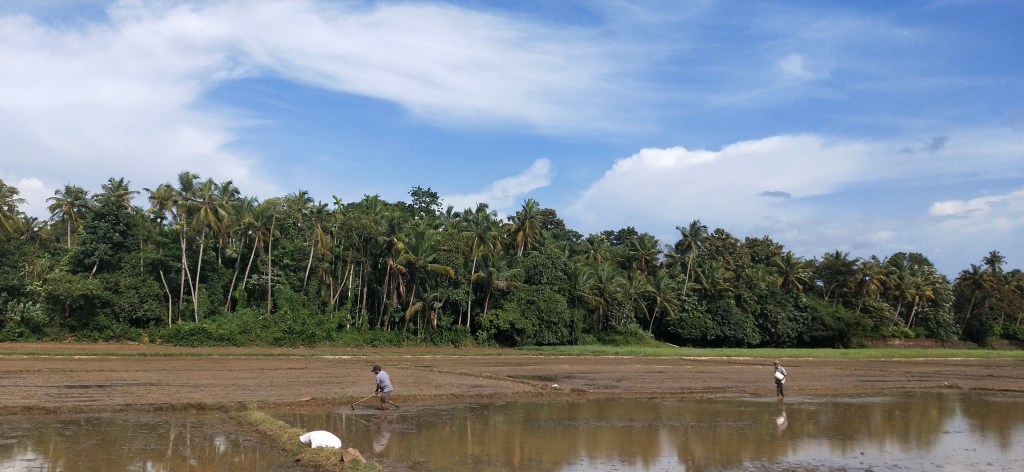
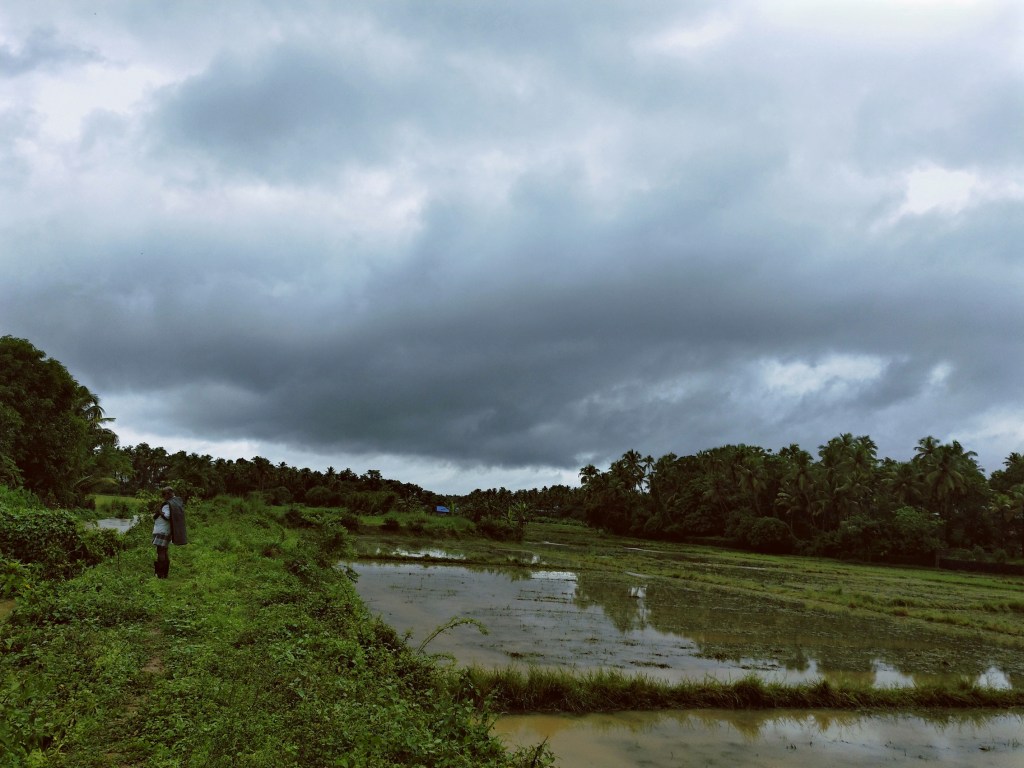
The Setting: Midland paddyfields in Kerala
The midland paddy fields of Kerala are situated at an elevation range of 4-30 m above msl, in the basins of short west-flowing Western Ghat rivers. They form small pockets of 10-100 ha (0.01 – 1 sq.km) area, fringed by gently sloping garden lands and homesteads. The midland paddy fields act as natural reservoirs of rainwater, often giving birth to first and second order streams that feed the main rivers in their mid and lower courses. These paddy fields function as floodplains during monsoons when the rivers are in full spate. They enrich the local ground water tables. A network of small ponds in and around these paddy fields further accentuate the hydrological significance of this midland landscape. According to the regional geography and climate, first (Virippu – tuned to the SW monsoons) or second crop (Mundakan timed to the NE monsoons) paddy or both are cultivated in these fields spread across the state. During summers, vegetables or short duration paddy are grown in fields equipped with irrigation facilities.

Nearly 80% (6000 sq.km) of the midland paddylands were permanently converted post 1970s (Figure 1) for various non-agricultural resource extractions, real estate speculation, infrastructure development projects, cultivation of non-rice seasonal crops of banana and tapioca or perennial tree crops of coconut, arecanut, nutmeg and rubber, following complex social, political and economic pathways. Land fragmentation after the State land reforms, largescale migration to the Middle East, the resultant remittance economy, labour shortages, high production cost and low produce price for paddy were all instrumental in the extensive conversion of wetland paddy fields.

The Kerala Conservation of Paddy Land and Wetland Act came into effect in 2008, by which time a major share of the paddylands had already disappeared. Post 2008, there is a reluctant stemming of widespread private conversions and rekindled interest in paddy farming, aided by government schemes for fallow land farming, reasonable minimum support price and assured produce procurement through the state machinery. Ironically, state sanctioned conversions continue unabated: for highway expansions, fuel storage facilities, railroad projects, bus-stations and mega real estate projects. Midland paddy fields continue to be eyed by a land hungry ‘development nexus’, even while the value of this landscape in flood regulation has now been made abundantly clear post the 2018 deluge.
Farming under greater uncertainty
We farm in a 50 acre (0.2 sq.km) midland paddyland polder as a group farming society in the Karuvannur river basin in central Kerala in Thrissur district. The river basin has two reservoirs upstream of us – the Peechi irrigation project on the Manali tributary and the Chimmoni irrigation project on the Kurumali tributary. The Manali and Kurumali join to form the Karuvannur river just 7 km downstream of our paddy polder. A first order stream passes through our fields which is equipped with a small lift irrigation scheme for summer water needs. The stream joins the Manali river about 3 km further downstream and when the river water level rises, water flows back into our fields through this stream. Our polder cannot be farmed during the first crop season during which time it stays completely flooded. We cultivate the Mundakan paddy and if time, money, weather and water aligns, summer vegetables.

A lighter SW monsoon in 2020, compared to the fierce rains of 2018 and 2019, gave us an early start to the second crop season. Ploughing, manuring, lime application, field levelling, bund making and seed treatment were done under a clear sky.

We opted for two indigenous medium duration (150-160 days) rice verities this year, Chitteni and Kuttadan, both of them tolerant to flood conditions for brief periods. Other farmers in our polder opted for a short duration (120 days) high yielding variety ‘Uma’. We completed sowing by the last day of August, a week earlier than usual. The dreaded time immediately following sowing passed by without rains. Once the seeds germinate and take root in the soft pulverised mud, we are normally in the clear. It was not to be. A heavy spell of rain during September third week lasted for four days. Normally three week old seedlings survive heavy rainfall and short floods. However, the dam shutters of the upstream Peechi reservoir were opened without early downstream warnings following heavy rains on 21st September 2020. The spill release into the Manali river backed up into our fields through the stream, completely inundating the crop. Due to the heavy inflow, bunds were breached at several locations.
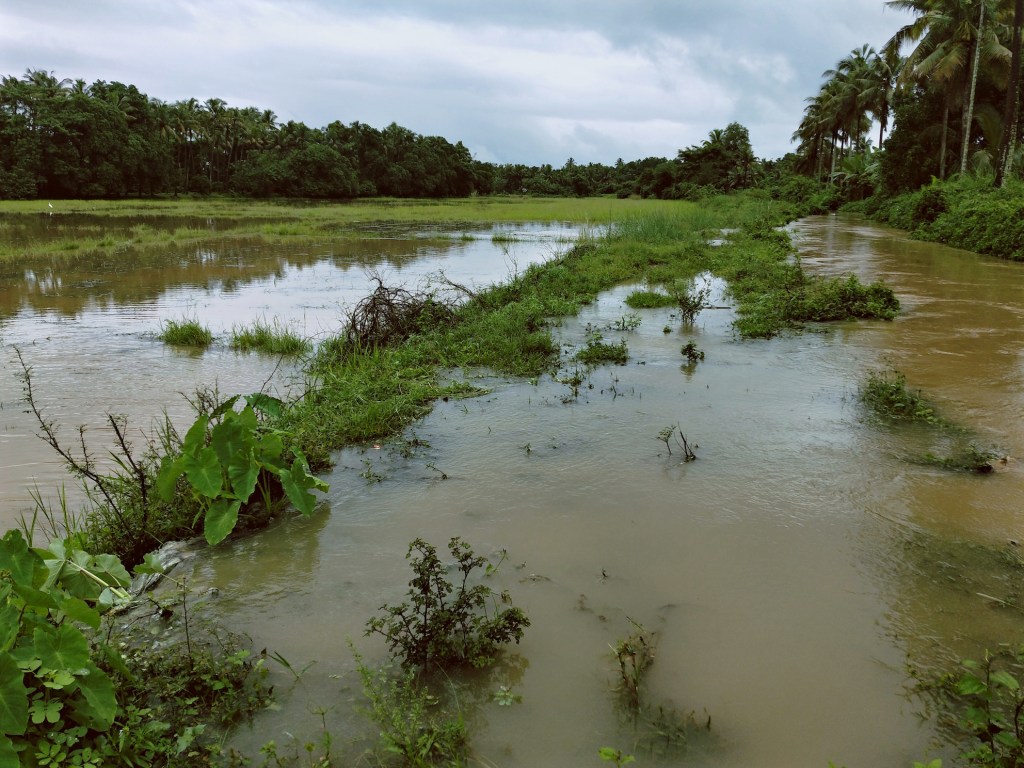
Despite the hard lessons of 2018, reservoir management in the state has not undergone any scientific overhauling and continues to be ad hoc. The dam authorities approached the District Disaster Management Authority for sanction of spill release from Peechi dam on 21.09.2020 only after the reservoir water level reached 78.45 m against the water release level 78.40 m[1]. Even while the district was on Orange Alert and there were IMD warnings regarding low pressure building up in the Bay of Bengal[2], the dam authorities were reluctant to take sanction a priori.
Last mile reach of warnings continues to be abysmally poor. Even now there are no expedited official channels that would forewarn the downstream about reservoir spill releases, emergency or otherwise. We did not receive any prior notice on the release of spill from the Peechi reservoir through the Village, Panchayat or the Agricultural office. In fact, the concerned Agricultural Officers were themselves not aware of the decision nor were they attuned to the possibility of crop damage due to release of upstream dam waters. We later went through the Order of the DDMA Chairman sanctioning the release (Order No. K 1 – 4286 / 2020 (02)[3] dated 21.09.2020). It states that in the context of the 2018 floods, the district is taking proactive measures towards preparedness and prevention. The good intentions fail when we realise that the Vallachira panchayat and or the Edakunni village in Thrissur Corporation in which our paddy field is situated is not part of the list of Offices where the Order was forwarded to. This is hardly surprising since there has been no exercise to map the downstream flood plains and impact areas of reservoir release for any reservoir in the state. It is clear that our administrative system is not yet equipped for the changed and highly uncertain nature of the world we live in. We continue to deal with disasters as emergencies and not with preparedness.
The situation became grave when due to a valve dysfunction at the Peechi dam, our paddy remained under stagnant water for an entire week. One of the check valves located on the sides of the spillway shutters, which control the flow of water to the small hydro project at Peechi, had malfunctioned after timbers logjammed it. This resulted in a gap of four metres in the gate located inside the dam at a depth of 20 metres, forcing the other gates also to remain partially open to stop the rising water levels in the dam[4],[5]
https://tv.mathrubhumi.com/en/news/kerala/valve-to-power-plant-in-peechi-dam-damaged-1.62506
A team of naval divers from the Southern Naval Command had to work continuously for four days before the faulty mechanism could be repaired by 27/09/2020[6]. During this entire period, the downstream river water level continued to be high, inundating our paddy completely; a longer time than normal under a moderate rainfall event (less than 10 cm). Flooding by rainfall ebbs as the rains subside, giving the submerged plants some breathing time. The reservoir spill on the other hand can remain in the field as long as the spill release raises the river levels and therefore takes longer to recede.
The flood tolerant deep water rice varieties rapidly elongate when inundated in an attempt to stay above water. By the time Naval divers removed the blockades and closed the valve of the mini hydel station and dam spillway gates were shut, our seedlings had elongated and promptly lodged in the fields, when waters receded. A week’s sunshine, the next dose of manuring and gap filling could save the crop, but we were acutely aware of the increased uncertainties in getting through the season.

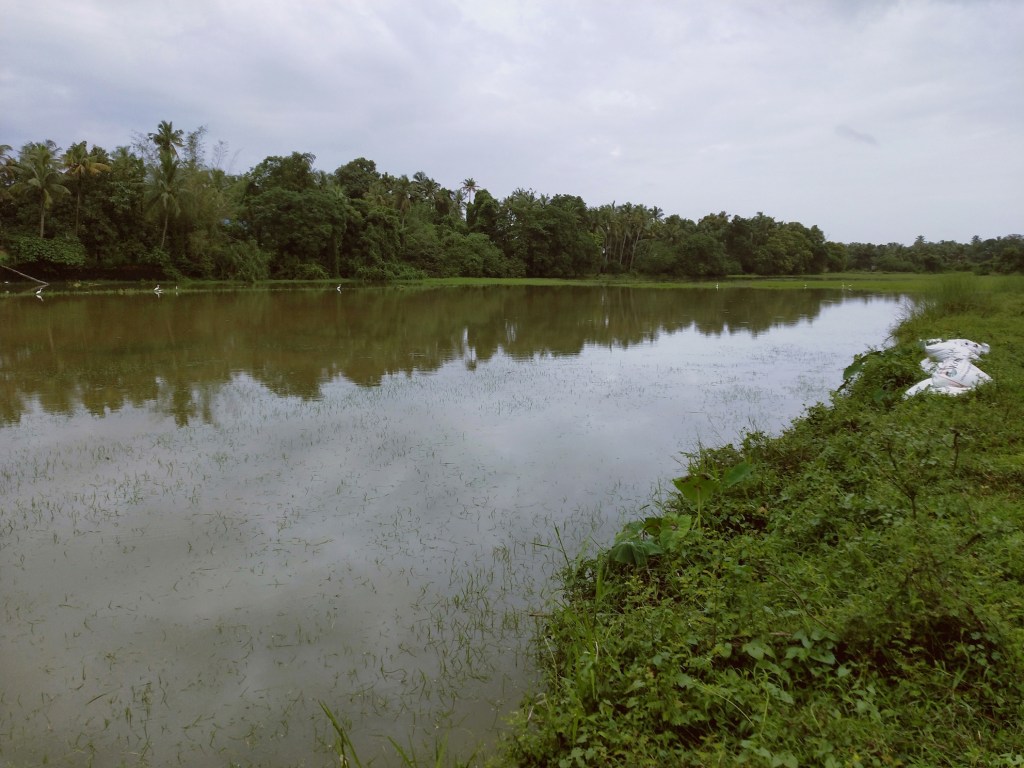


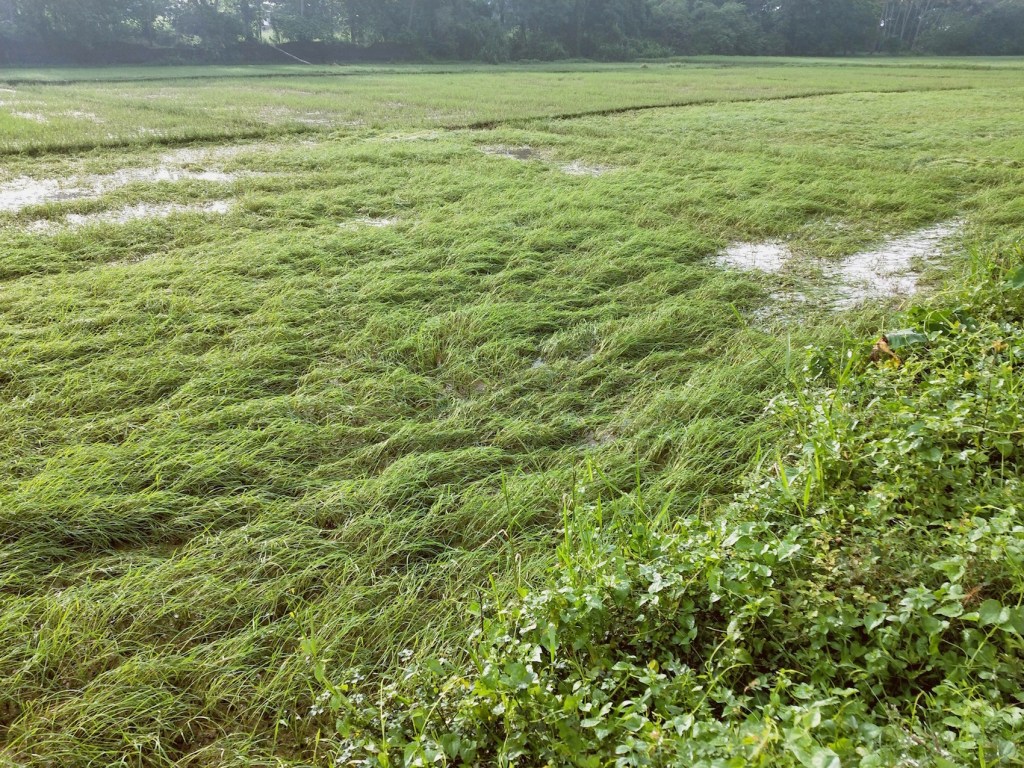
Three months later, we had to resort to irrigation due to sparse NE monsoons. Our neighbours’ shorter duration paddy was harvested in the first week of January and approved for transport to the mills through the state paddy procurement system, the SUPPLYCO. Hot days, clear skies and the harvested paddy were left out in the fields. A rogue spell of rainfall on 6th and 7th January 2021 drenched the entire paddy stocked for procurement on the field bunds. Various parts of the country reported rainfall during the time; extremely rare for January and upsetting agricultural rhythms. The sodden grains now need to be dried again before the entire crop go waste by sprouting. The rains also soaked and ruined this season’s straw left in the fields waiting for the baler machine (The sale of the paddy straw mostly covers the cost of harvest as straw fetches a good price these days). Our indigenous varieties being of longer duration, are still in the field, almost ripe. They are taller in stature and have lodged in the field. The untimely rain spell is not good for them too.

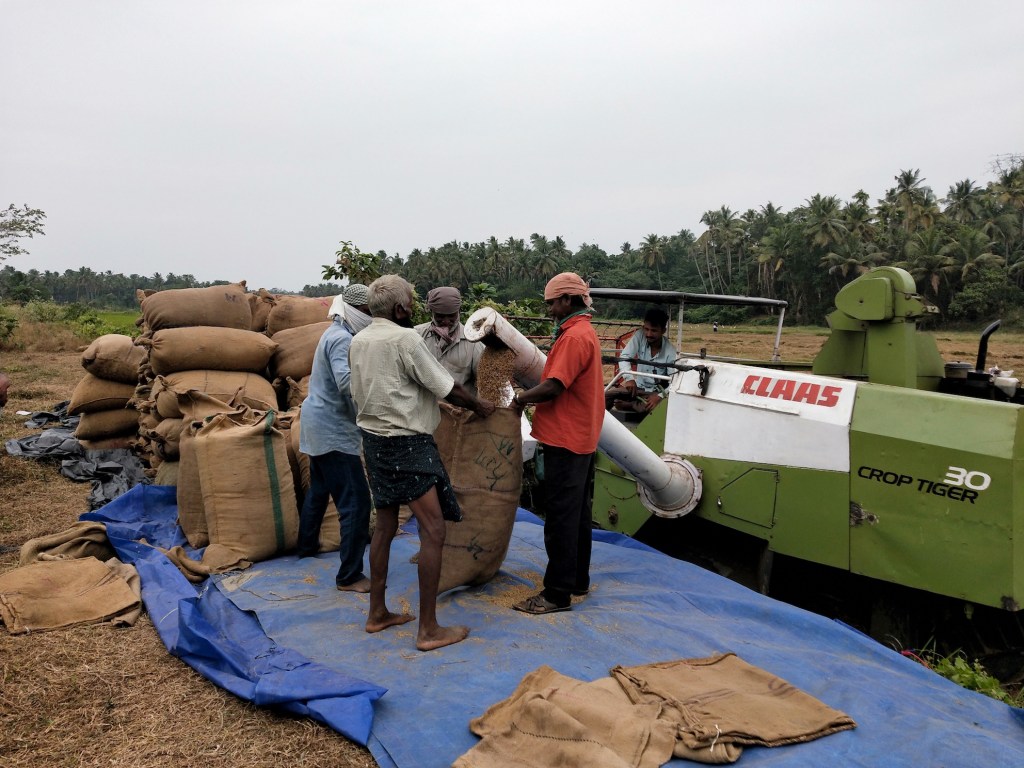

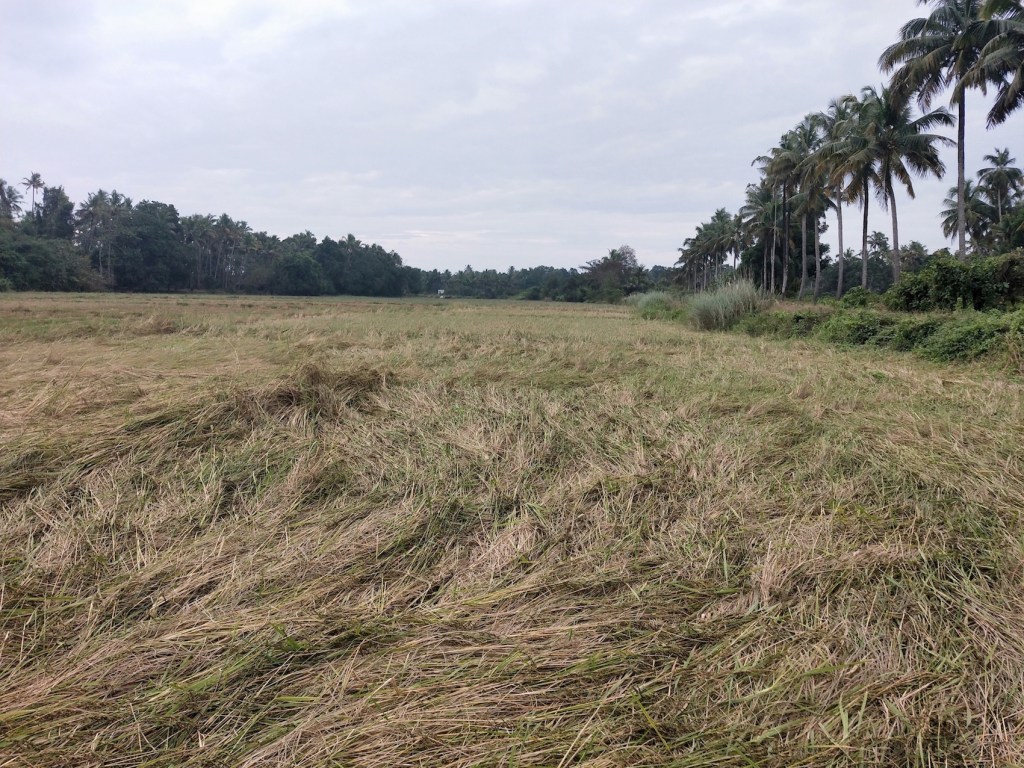
Administrative interstices
The socio-economic profile of paddy farmers has changed in the state from large land-owners to small homesteaders (like us) and lease farmers who take entire paddy polders on lease for a season. These farmers do not have the infrastructural resilience to override even such small but staggering quirks of a changing climate. They do not own large yards for drying or warehouse spaces for storing grains for the short time before the mills take it off their hands.
It is here that the administrative system/ local self-governments (LSG) have greater discretionary roles to play and novel functions to fulfil. For instance, utilizing the powers vested on them by the Disaster Management Act 2005, the District Collectors can direct the Agricultural Officers within their jurisdiction to prepare lists of public/ private buildings such as schools, marriage halls, tile factories etc. with large yards and storage facilities that can be requisitioned to help out the farmers who are in need of storage spaces and drying yards for a short period of unexpected inclement weather. The Agricultural Officer could be assigned as the Nodal Officer to whom applications for the use of such a facility can be made. The LSG can also take proactive steps in this direction[7].
The lack of knowledge among administrators on the extent of flood inundation in the downstream floodplains upon release of dam waters continue to be unaddressed in the state. There is an urgent need to carry out flood inundation mapping and establish a sound and effective early warning system. Even a day’s advance notice on dam releases can give time to the farmers to act on the information by draining out water, strengthening bunds, opening/ closing of waterways as per the field condition and be generally on the alert.
The fact is, we live in times when the resource poor require greater support and kinder, stronger measures to adapt to the increasingly uncertain world. The small and lease farmers are the most vulnerable as they have to face this changed climate reality on a daily basis. Farming has always been uncertain. It depended on the idiosyncrasies of the rains and the market; it had to brave natural and manmade disasters. It is disappointing and demeaning that rather than strengthen the societal and administrative support and device inspired measures to address the changing nature of challenges, we are set to destroy even the existing meagre support systems.
Dr. Sreeja KG and Dr. Madhusoodhanan CG (kg.sreeja@gmail.com)
END NOTES:
[1] https://thrissur.nic.in/document/opening-of-peechi-dam-ddma-order-21-9-2020/
[2] https://english.mathrubhumi.com/news/kerala/imd-forecasts-extremely-heavy-rainfall-in-kerala-red-alert-in-various-districts-1.5065935
[3] https://thrissur.nic.in/document/opening-of-peechi-dam-ddma-order-21-9-2020/
[4] https://tv.mathrubhumi.com/en/news/kerala/valve-to-power-plant-in-peechi-dam-damaged-1.62506
[5] https://www.thenewsminute.com/article/valve-turns-faulty-peechi-dam-kerala-water-overflows-through-pipe-powerhouse-133690
[6] https://indiannavy.nic.in/content/repair-work-peechi-dam-naval-diving-team
[7] We requested for the use of a local public community hall through the ward councillor. A request was put up at the Zilla Panchayath for the use of the hall temporarily for drying and storing the harvested grains, under the purview of the Disaster Management Act 2005.
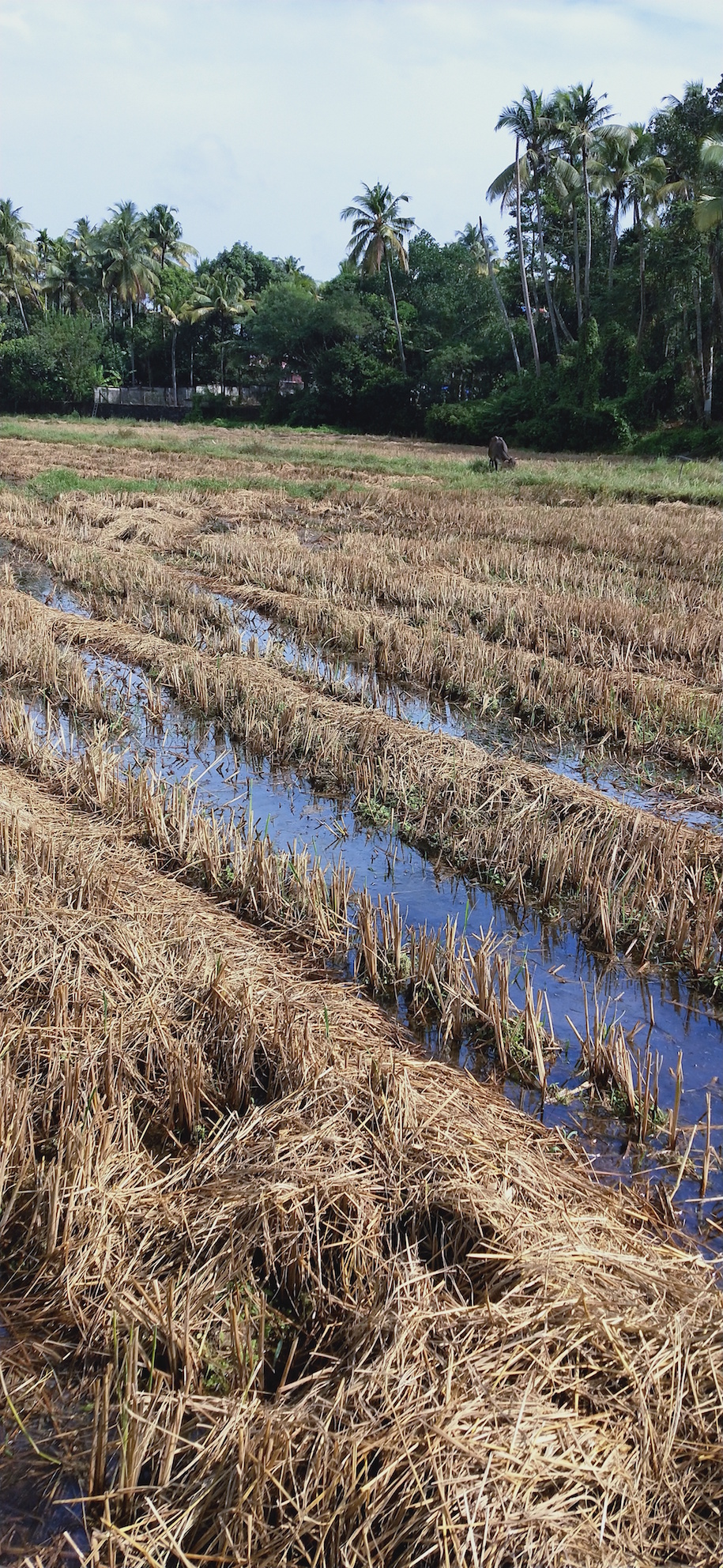
One thought on “Paddy farming in times of climate change – field notes”